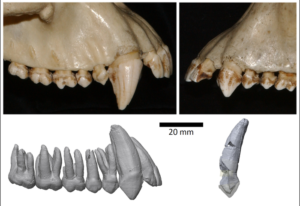
PROCEEDINGS OF THE NATIONAL ACADEMY OF SCIENCES—A reduction in male canine tooth size and, possibly, aggression occurred early in human evolution, according to a study. Proportionally, humans have the smallest male canine teeth among all anthropoids and exhibit little sexual dimorphism in canine tooth size. The timing of emergence of weak canine tooth sexual dimorphism in human evolution is unclear, partly due to the difficulty of reliably determining dimorphism in weakly dimorphic fossils. Gen Suwa and colleagues applied statistical methods to estimate and compare levels of sexual dimorphism in a dataset of fossil canine teeth, including all available Ardipithecus ramidus fossils as well as fossils from Australopithecus spp., Homo spp., and extinct apes. The results suggest that weak canine tooth sexual dimorphism has characterized members of the human clade since as early as in A. ramidus, around 4.5 million years ago. The authors estimate that canine tooth sexual dimorphism in A. ramidus was lower than in bonobos, the extant ape with the lowest canine tooth dimorphism, and comparable to levels seen in modern humans. This estimate places the reduction of male canine teeth early in human evolution, broadly coinciding with the development of bipedalism. Because larger male canine teeth are associated with increased aggression and competition between males in extant anthropoids, the results suggest a behavioral shift early in human evolution toward reduced aggression between males, likely mediated by female choice, according to the authors.
______________________________

Comparison of the upper canine teeth of a male common chimpanzee, Pan troglodytes (upper left), a female chimpanzee (upper right), a male A. ramidus (lower left), and a female A. ramidus (lower right). Gen Suwa.
______________________________
Article Source: PNAS news release
*“Canine sexual dimorphism in Ardipithecus ramidus was nearly human-like,” by Gen Suwa et al., Proceedings of the National Academy of Sciences, 29-Nov-2021. 10.1073/pnas.2116630118
______________________________
Advertisement



